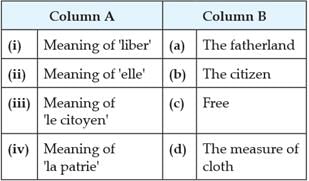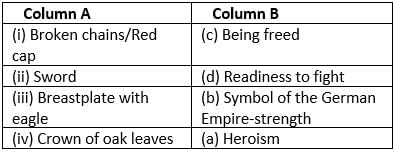Assertion & Reason Test: The Rise of Nationalism In Europe - Class 10 MCQ
15 Questions MCQ Test Social Studies (SST) Class 10 - Assertion & Reason Test: The Rise of Nationalism In Europe
Direction: Mark the Option Which Is Most Suitable:
Assertion : Italy was divided into seven states, of which only one was ruled by an Italian princely house.
Reason : The north was under the domination of the Bourbon kings of Spain.
Direction: Mark the Option Which Is Most Suitable:
Assertion : Giuseppe Mazzini worked with the conservatives for the monarchy.
Reason : Italy had to continue to be a patchwork of small states and kingdoms.
| 1 Crore+ students have signed up on EduRev. Have you? Download the App |
Direction: Mark the Option Which Is Most Suitable:
Assertion : From the very beginning, the French revolutionaries introduced various measures and practices like the idea of la patrie and le citoyen.
Reason : This was done to create a sense of collective identity amongst the French people.
Direction: Mark the Option Which Is Most Suitable:
Assertion : On 18 May 1848, 831 elected representatives revolted in the Frankfurt parliament.
Reason : The elected representatives revolted against the issue of extending political rights to women.
Find the incorrect option:
Find the incorrect option:
Analyze the information given below, considering one of the following correct options:
While it is easy enough to represent a ruler through a portrait or a statue, how does one go about giving a face to a nation? Artists in the eighteenth and nineteenth centuries found a way out by personifying a nation. In other words, they represented a country as if it were a person.
Analyze the information given below, considering one of the following correct options:
He was perhaps the most celebrated of Italian freedom fighters. He came from a family engaged in coastal trade and was a sailor in the merchant navy. In 1833, he met Mazzini, joined the Young Italy Movement and participated in a Republican uprising in Piedmont in 1834.
Arrange the following in the correct sequence:
(i) Slav nationalism was the go to force in the Habsburg and Ottoman Empires.
(ii) Unification of Germany.
(iii) Victor Emmanuel II was declared as the king of united Italy and Rome was declared the capital of Italy.
(iv) The Prussian King, William I was proclaimed the German Emperor.
Arrange the following in the correct sequence:
(i) Treaty of Constantinople
(ii) First upheaval took place in France
(iii) Lord Byron died
(iv) Greek Struggle for independence begins
Match the following items given in column A with those in column B.

Match the following items given in column A with those in column B.

In the question given below, there are two statements. One is marked as Assertion (A) and other as Reason (R). Read the statements and choose the correct option :
Assertion (A) : Giuseppe Garibaldi was an Italian General, politician and nationalist who played a large role in the history of Italy.
Reason (R) : He was the architect in the process of nation-building.
In the question given below, there are two statements. One is marked as Assertion (A) and other as Reason (R). Read the statements and choose the correct option:
Assertion (A) : A large part of the Balkans was under the control of the Ottoman Empire.
Reason (R) : The spread of the ideas of Romantic Nationalism in the Balkans together with the disintegration of the Ottoman Empire made this region very explosive.
In the question given below, there are two statements. One is marked as Assertion (A) and other as Reason (R). Read the statements and choose the correct option:
Assertion (A) : The French Revolution was an influential event that marked the age of revolutions in Europe.
Reason (R) : The French Revolution transferred the sovereignty from the people to the monarch.
|
64 videos|445 docs|87 tests
|
|
64 videos|445 docs|87 tests
|


















